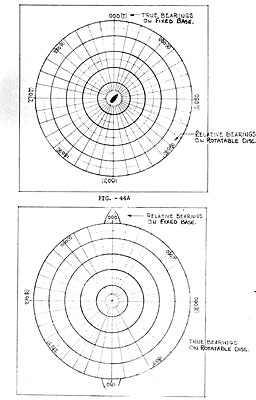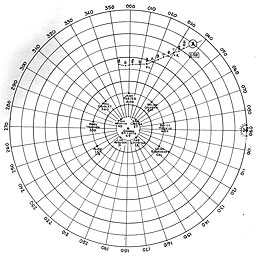
4000. UTILIZATION OF PLOTS
IDENTIFICATION.
During the complicated maneuvers of a night engagement when ships of opposing forces are rapidly changing station relative to each other, and at times even mingling with each other, it becomes impossible for the operators of radar sets to keep track of the varied pips on scopes or to tell friend from foe.
IFF is a primary means of doing this but has not as yet been developed very extensively for surface use. The air search radar with the BL was not designed for the identification of surface units. Further, IFF is subject to battle casualty and material failure. Too, the day may come when the enemy uses IFF deceptively. Methods other than IFF alone are needed to keep contacts identified. Proof of this is the fact that combatant units of our Navy in the confusion of action have unwittingly fired upon their own units.
The use of plots for identification has been evolved as an additional primary means of continuous identification. By keeping track of all units on a plot from the beginning of an engagement when opposing forces are distinctly separated and distinguishable, it is possible to maintain the location of all friendly units relative to hostile units during the tactical maneuvering and melee of battle. Identification can be accomplished on any of the basic types of plots, Summary, Surface, Air or Geographic. A ship prepared with such a display will not fire on its own forces.
OTHER USES OF PLOTS.
Under ordinary cruising conditions, a plot of surface vessels in company is required. It may be kept on a Geographic Plot or a Summary Plot, but is more commonly kept on a Surface Plot. By establishing each ship's station on the plot, early detection of radical movement may be made. The actions of a destroyer sheering from the screen to pursue a sonar contact are quickly known to other units, allowing them to take appropriate action. Ships on collision courses are readily apparent and are notified over TBS.
Before broadcasting surface contacts picked up by own ship's radars, to other ships over warning net, we must convert the bearings and ranges from us to bearings and ranges from fleet center. This conversion, as well as the conversion of information reported to us over warning net, is made on the summary dot. In emergencies, as in the case of a close-in surfacing submarine or a sonar contact, the detecting ship will probably report the bearing and range from herself over the warning net. To find the position of this, emergency contact from our ship, it must be plotted from the reporting ship. Similarly when own ship picks up a possible target, its position from one of the ships in the screen may be quickly determined and the information sent to that ship so that she may investigate. Plots must be used to prevent own ship firing on own ships or planes. Either a Summary Plot or a Surface Plot can be used to reveal any ship of own force that unknowingly, in the confusion of an action, maneuvers into the line of fire between your own ship and the target. In the event of a night air attack, a Summary Plot will show whether or not a sector is clear of ships for secondary battery fire.

